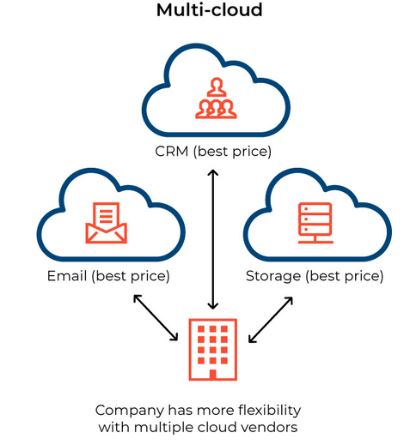Cloud Computing - Multi Model
Cloud deployment models describe how cloud computing resources and services are hosted, managed, and made available to users and organizations. It simply refers to delivering computing resources, such as servers, storage, databases, software, and applications, over the Internet.
5. Multi Cloud
Multicloud computing, as this word suggests, is the use of multiple public cloud services from different vendors within one architecture at the same time. Multi-cloud is a cloud computing strategy that involves using multiple cloud service providers to meet an organization's computing and storage needs. Instead of relying on a single cloud provider, such as Amazon Web Services (AWS), Microsoft Azure, or Google Cloud Platform (GCP), organizations adopt a multi-cloud approach to leverage the strengths and capabilities of multiple cloud providers.
A common example would be the use of public cloud services such as Google Drive and Dropbox to store and transfer documents.

Advantages of Multi Cloud
- Vendor Independence - By using multiple cloud providers, organizations can avoid vendor lock-in and maintain negotiating power when dealing with providers.
- Redundancy and Resilience - Multi-cloud setups enhance redundancy and resilience. If one provider experiences an outage, workloads can be shifted to another provider to maintain service availability.
- Cost Optimization - Organizations can choose the most cost-effective cloud services for specific use cases, potentially reducing overall cloud spending.
- Geographical Diversity - Multi-cloud allows organizations to store data in specific geographic regions or data centers to meet regulatory and data sovereignty requirements.
- Improved Performance - By deploying resources closer to end-users or specific geographic regions, organizations can potentially improve application performance and reduce latency.
- Best-of-Breed Services - Organizations can select the best cloud services from different providers for their unique needs, taking advantage of each provider's strengths.
- Risk Mitigation - Distributing workloads across multiple cloud providers can help mitigate risks associated with service outages, security vulnerabilities, or changes in a single provider's offerings.
- Hybrid Cloud Integration - Multi-cloud can seamlessly integrate with on-premises data centers and hybrid cloud deployments, providing a unified approach to managing both cloud and on-premises resources.
Disadvantages of Multi Cloud
- Complexity - Managing multiple cloud providers can be complex, requiring expertise in each platform, which can lead to increased operational complexity and potential skill gaps.
- Cost Management - While multi-cloud can optimize costs, it can also introduce challenges in tracking and managing spending across different providers.
- Data and Application Portability - Ensuring that data and applications can move seamlessly between different clouds can be challenging and may require additional development efforts.
- Security and Compliance - Managing security and compliance across multiple cloud environments can be more complex, as each provider may have its own set of security tools and compliance standards.
- Interoperability - Integrating services and data between different cloud providers may require custom development and may not always be straightforward.
- Vendor-Specific Tools - Organizations may become reliant on vendor-specific tools and APIs, making it harder to switch providers in the future.
- Resource Fragmentation - Without careful management, resources can become fragmented across multiple providers, making it difficult to track and optimize resource utilization.
- Vendor Relationships - Managing relationships with multiple cloud providers can be time-consuming and require dedicated vendor management.
Next
